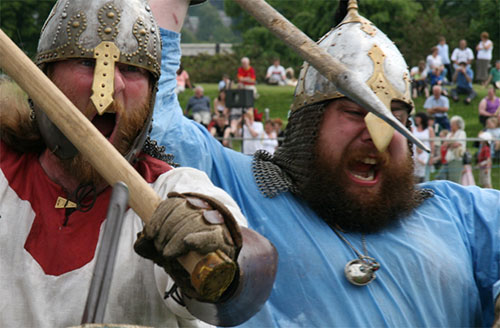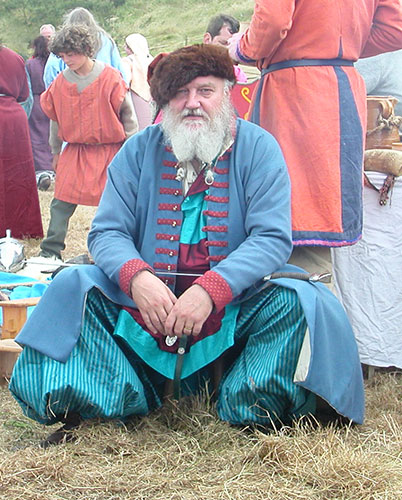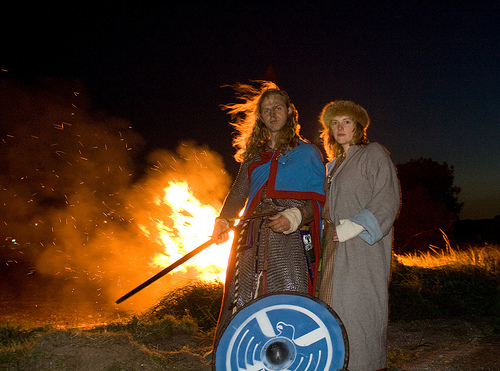There was a BBC programme I watched with my daughter when she was a wee girl – I am sure loads of people remember it. Mr Benn has become something of a cult since and you can still get the books, but for those currently scratching their bums and wondering what the hell I am talking about, I will explain.
Mr Benn was a cartoon character, a little bowler-hatted man who left his home at 52 Festive Road (go figure how I remember THAT!) and walked to a local shop, where a little man with a fez ushered him into a changing room. There Mr Benn put on whatever costume had been left for him, then exited through a back door and into an appropriate adventure. Eventually, the fez-hatted shopkeeper would usher Mr Benn back to the changing room and he’d put on his suit and bowler-hat – until the next time.
Mr Benn should be the patron saint of reenactors.
In the beginning, that’s what the hobby of Viking reenactment was all about – a dress-up pageant, where you could play ‘pretend’ and be six years old. It was enough to wrap strips of fake sheepskin Lamtex round your lower leg and climb into a biker jacket; any public entertainment was incidental, since this was just a bunch of like-minded overgrown weans rolling about in a muddy field. Even the women …
Of course, it did not stay like that. The Public started Asking Questions and, in order to answer them with at least some degree of sense and truth, folk began researching the period. After a while, the Lamtex went. Then the biker jackets. In the end, we had Authenticity Officers …

Now, if you want to dress like a Viking, you purchase a copy of the 1958 movie of the same name. You drool over Kirk Douglas’ fabulous winged helmet, Ernest Borgnine’s magnificent jerkin of diamond-plate studs and – if you are a woman – Janet Leigh’s improbably-breasted dresses.
Then you grip it securely in both hands and sling it in the bin, since almost none of it is accurate.
What is accurate is surprisingly varied and versatile. Wool and linen and even silk as fabrics. Leather and sealskin, wolf, fox and other furs and skins. You can have almost any colour you like save, peculiarly, black – no-one in the Dark Ages found a mordant suitable to fix black as a permanent dye.

We know this because the archaeology has exploded in the decades between when The Vikings began, back in the Sixties. There is hardly a woman in the Vike – or a man, now, for that matter – who does not know how to get yellow dye out of onion skins, or why Hiberno-Norse are the only ones allowed to wear purple (from heather) apart from the exotic Rhus of the Russian east (who got it from Byzantium). There are few Viking reenactors who do not know their proper status and why they can’t have ornamental bling with a plain, undyed tunic, or why a sword is a luxury item, or why their helmet has no wings or horns and never will have.

It comes as a surprise to some and almost all of the public to find out how warm a wool cloak is in winter, or how wet-proof a pair of sealskin boots are, or how the Norse sailors developed the sleeping-bag in sealskin and foul-weather gear from walrus hide which as good as modern Neoprene.
Of course, getting all this gear isn’t easy. You can’t buy it, so almost all the Viking reenactor women I know are expert seamstresses. Most of the men can turn out a pair of simple leather shoes. Several are now expert armourers and have turned it into a full-time, museum-supplying business. Others make hats, leather belts and sheaths, silver jewelry … everything we wear is handmade, handstitched and lovingly crafted.

Of course, you can’t walk out and club a cub these days – well, not without creating a bit of a stir – so all the skins and furs have to be laboriously sourced from countries who legitimately cull the likes of seal, wolf, boar and the rest. That then needs to be addressed in presentations to the public, especially in schools, where Glasgow Vikings in particular do a lot of serious primary education.
But the more we strive to educate and explain, the more interest is engendered and that manifests itself in many ways, from Time Team to the History Channel to museum funding for exhibitions such as this one.
So when you next see a Viking, take a long, hard look – all that gear, from his forged helmet to his leather soles, is unique, hand-made and an investment of love, time and money. We like to think that the decades of striving to be more than biker jackets and Lamtex have contributed to keeping alive an age long gone but not forgotten.
Find out more about Robert Low and the Glasgow Vikings here.
